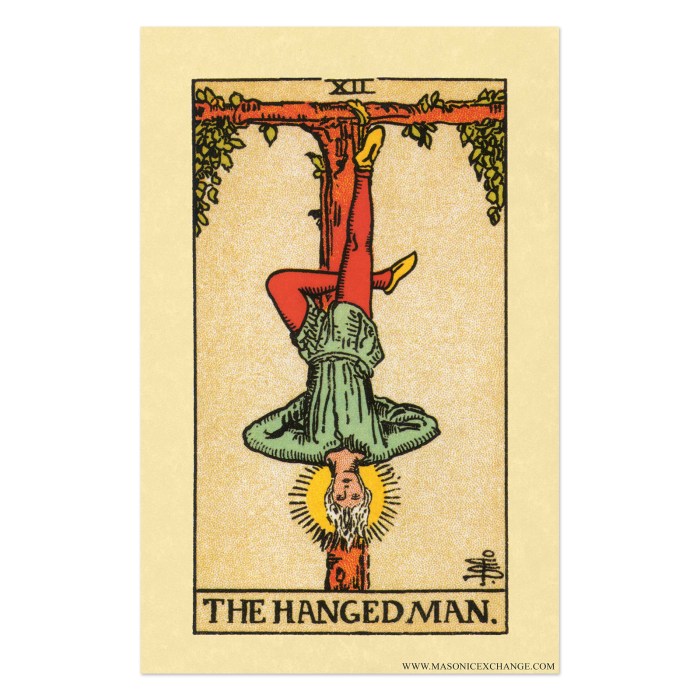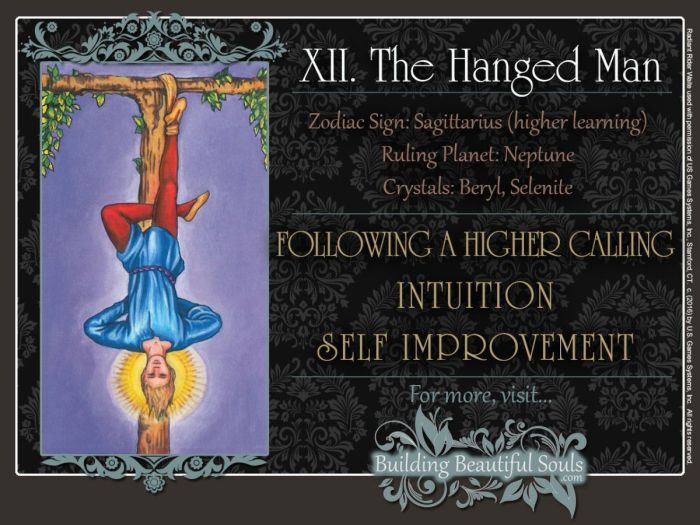The evocative phrase “binds of the hanged man” invites us on a captivating journey through history, literature, and human experience. Its origins and meanings, both literal and metaphorical, set the stage for a profound exploration of the constraints and potential for liberation that shape our lives.
From ancient myths to modern literature, the phrase has served as a potent symbol, reflecting the struggles, sacrifices, and aspirations of humanity. Its enduring relevance speaks to the universal human condition, reminding us of the forces that bind us and the indomitable spirit that seeks freedom.
Origin and Meaning: Binds Of The Hanged Man

The phrase “binds of the hanged man” has its roots in the dark history of capital punishment. In the past, condemned criminals were often hanged as a form of execution.
The “binds” in this phrase refer to the ropes or chains used to secure the prisoner’s limbs before they were hanged. These binds served both a practical and a symbolic purpose. They prevented the prisoner from resisting or escaping, and they also represented the constraints and limitations that bound the condemned individual.
Literal Meaning
In its literal sense, the phrase “binds of the hanged man” refers to the physical restraints used during an execution.
Metaphorical Meaning
Beyond its literal meaning, the phrase “binds of the hanged man” has also acquired a metaphorical significance. It can be used to describe any situation in which an individual feels trapped, restricted, or unable to escape.
Literary and Cultural Significance
The phrase “binds of the hanged man” has been used extensively in literature, poetry, and folklore. It often serves as a metaphor for entrapment, oppression, or inescapable circumstances.
In William Shakespeare’s Hamlet, the protagonist grapples with the “binds” of his father’s ghost, which compels him to avenge his murder.
Literary Interpretations
- In Emily Dickinson’s poem “After the Blizzard,” the speaker describes the “binds” of winter as suffocating and unforgiving.
- In Toni Morrison’s novel Beloved, the character Sethe is haunted by the “binds” of her past trauma.
Cultural Representations, Binds of the hanged man
- In tarot card readings, the “Hanged Man” card represents a state of suspension or sacrifice.
- In some cultures, the “binds of the hanged man” are associated with the concept of limbo, a state of neither heaven nor hell.
Symbolism and Interpretation

The phrase “binds of the hanged man” carries profound symbolic meanings that invite contemplation and interpretation. The “binds” represent the constraints, limitations, or oppressive forces that restrict an individual’s freedom or potential. These binds can manifest in various forms, such as societal expectations, personal insecurities, or external circumstances.
The “hanged man” serves as a potent symbol with multiple interpretations. In some contexts, it represents the ultimate sacrifice or martyrdom, embodying the idea of giving up one’s life for a greater cause or belief. Alternatively, it can symbolize a state of suspension or liminality, where the individual is neither fully alive nor completely dead, but rather in a transitional phase.
Constraints and Limitations
- The “binds” can represent societal norms and expectations that confine an individual’s choices and aspirations.
- Personal insecurities and self-doubt can act as internal “binds,” hindering an individual’s ability to pursue their goals.
- External circumstances, such as poverty, discrimination, or political oppression, can impose significant “binds” on an individual’s life.
Sacrifice and Martyrdom
The “hanged man” as a symbol of sacrifice and martyrdom evokes the idea of giving up one’s life for a higher purpose or belief.
The “binds of the hanged man” is a term that refers to the ligature marks left on the neck after a hanging. If you’re curious about the veins in the body, you can take a veins of the body quiz to test your knowledge.
The “binds of the hanged man” are caused by the pressure of the ligature on the veins in the neck, which can lead to swelling and bruising.
- In religious contexts, the “hanged man” may represent the ultimate sacrifice made by divine figures or martyrs.
- In social or political movements, the “hanged man” can symbolize individuals who have sacrificed their lives for the cause of freedom, equality, or justice.
Liberation and Transformation
In some interpretations, the “hanged man” represents a state of liberation or transformation.
- The “binds” can be seen as the shackles of the past or old ways of thinking that are being shed.
- The “hanged man” can symbolize a period of introspection and self-discovery, leading to a profound transformation in one’s life.
- The “hanged man” can also represent the release from physical or mental suffering, as the individual transcends their earthly existence.
Psychological and Emotional Implications

The phrase “binds of the hanged man” carries profound psychological and emotional weight. The “binds” symbolize the internal struggles, self-doubt, and feelings of entrapment that can grip individuals.
These binds can manifest as psychological constraints, limiting one’s thoughts, actions, and emotions. They can evoke feelings of anxiety, fear, and hopelessness, creating a sense of being trapped within one’s own mind.
Internal Struggles
The binds represent the internal battles individuals face, such as grappling with unresolved trauma, insecurities, or negative self-perceptions. These struggles can weigh heavily on the mind, creating a sense of being bound and unable to move forward.
Self-Doubt
The binds can also symbolize the chains of self-doubt that hold individuals back. Negative thoughts and self-criticism can create a prison within the mind, limiting one’s potential and preventing them from reaching their full potential.
Feelings of Entrapment
The binds evoke a sense of entrapment, as if one is caught in a web of circumstances beyond their control. This can lead to feelings of helplessness and despair, making it difficult to break free from negative patterns and move forward.
Examples and Applications

The phrase “binds of the hanged man” continues to resonate in contemporary contexts, finding relevance in discussions surrounding freedom, justice, and human rights.
Modern Applications
*
-*Political Discourse
The phrase has been invoked in political speeches and writings to condemn oppressive regimes that restrict individual liberties and deny basic human rights.
-
-*Social Commentary
Activists and artists use the phrase to highlight the plight of marginalized groups and individuals who face discrimination and injustice.
-*Legal Proceedings
In legal contexts, the phrase may be invoked to argue against unjust laws or sentences that infringe upon fundamental freedoms.
Exploring Themes
*
-*Freedom
The phrase serves as a potent reminder of the importance of individual liberty and the need to resist oppressive forces that seek to restrict it.
-
-*Justice
It evokes the idea of accountability and the pursuit of justice for those who have been wronged or silenced.
-*Human Rights
The phrase underscores the universal and inalienable nature of human rights and the responsibility to protect them for all individuals.
Popular Questions
What is the origin of the phrase “binds of the hanged man”?
The phrase has its roots in ancient mythology and folklore, where it often symbolized the constraints and sacrifices associated with life and death.
How has the phrase been interpreted in different cultures?
The phrase has taken on diverse interpretations across cultures, ranging from a symbol of oppression and injustice to a representation of spiritual liberation and transformation.
What are the psychological implications of the “binds”?
The “binds” can represent internal struggles, self-doubt, and feelings of entrapment. They can evoke emotions of anxiety, fear, or even hope, depending on the context.